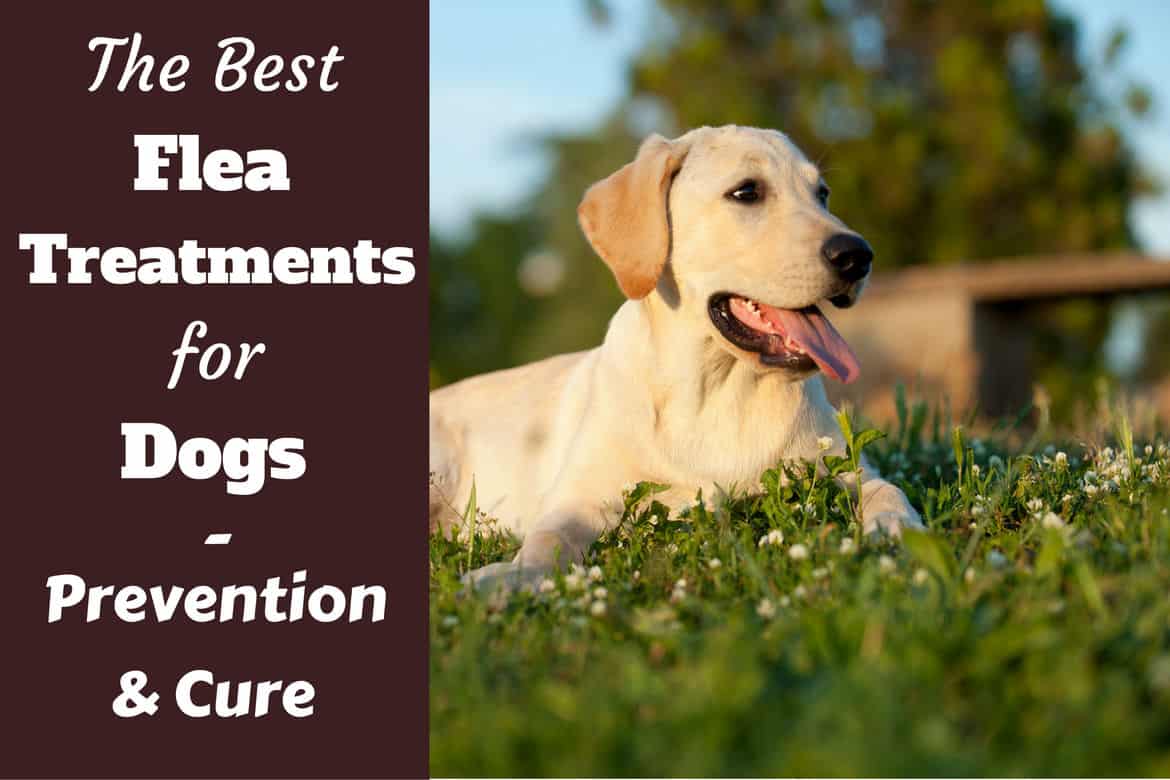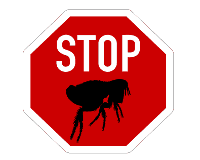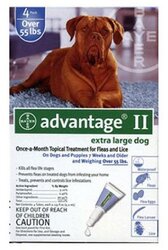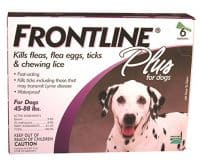This post may contain affiliate links. We may earn money or products from the companies mentioned in this post.

Photo Credit: © Depositphotos.com / diegobuonanno
Let’s face it: Our dogs are walking, barking, flea-attracting machines. It’s frustrating because no matter how well-groomed or often-bathed your pup is, they’re still a host for one the most annoying flea.
Fleas are pesky parasites that don’t discriminate. While our imagination likes to tell us that only mangy street mutts in cartoons get fleas, the first sign of fleas ruins that pipe dream. There’s nothing fun about a flea infestation; trust me.
Fighting with fleas can feel like a never-ending war, but we don’t have to let our pampered pooches fall victim to these battles.
As owners, we are our pups best line of defense, so we need to know how to fight fleas effectively.
Read on to discover both the best flea treatment for dogs, and what can you do to prevent fleas from ever rearing their ugly heads in your household. The war is ending, and you will be the victor with the help of the best flea medicine for dogs!
What Is A Flea?
Fleas are parasitic wingless insects, which live on the blood of birds and mammals.
There are many varieties of fleas, over 2000, in fact. And though there is a species known as the Dog flea (Ctenocephalides canis), in North America most canine flea infestations are actually caused by the Cat flea (Ctenocephalides felis).
Watch out:
Don’t let their lack of wings trick you into thinking they can’t get around. Their powerful back legs make them prodigious jumpers, and enable them to leap onto a new host with ease.
In fact, that’s how they found their way onto your pet in the first place, by leaping from the ground, or from another animal they’ve encountered.
Does My Dog Have Fleas? The First Signs
A dog with a flea infestation will be itchy in affected areas and will scratch and bite at itself. These are the first signs to look out for when you are worried about a flea problem.
This can be more than a simple nuisance:
- Puppies may become anaemic from the blood loss of a large infestation
- Dogs unlucky enough to be allergic to flea bites may become severely itchy
In an effort to achieve some measure of relief, an itchy dog may even scratch and chew itself to such a degree that it develops open sores, and that can lead to secondary infections.
It gets worse:
fleas can also carry and transmit a variety of diseases. Included among these are the Plague and Typhus, but your dog is more likely to become infected with tapeworms as a result of accidentally ingesting fleas while chewing at ‘hot spots.’
Signs Of Flea Allergy Dermatitis
There is another condition, FAD (flea allergy dermatitis) that you should be aware of. Some dogs have an allergy to flea saliva. If encountered, it can cause:
- redness
- bumps
- scabs
- severe hair loss
- infection
- and more!
Unfortunately, most flea treatments don’t kill fleas until after they bite, and at that point, your dog may already be suffering the effects of FAD if they are infected. If your dog develops any of these symptoms after a flea bite, you will want to thoroughly cleanse your house as you would if you had any full on flea infestation. Talk to your vet about how to prevent your dog from inflicting self-trauma because of the allergy pain.
Making Sure: How To Check A Dog For Fleas

Just because a dog is scratching, that doesn’t necessarily mean it has fleas.
But beware:
But if you notice your dog consistently scratching at the same spot, it’s a good idea to take a much closer look.
You may also notice that they’ve rubbed the irritated area raw, and it can even go as far as hair loss.
To check your dog for fleas, you’ll want to closely inspect the areas that provide the best hiding spots:
- check-square-o Look in armpits, around the groin and in the ears to start with, as these are typically dark and moist areas which are the kind of places fleas like to hang out.
- check-square-o Fleas are very small, about the size of a pinhead, and are dark in color.
- check-square-o Try using a fine-toothed flea comb to extract a few from close to the skin.
Another tell-tale sign is flea dirt, or flea excrement. Flea dirt looks like any other dark spots of dirt that might fall off your dog when you brush him. However, when you wet it, it will turn a dark red, because flea dirt is blood that the flea has digested and excreted.
Before Treating, You Must Understand The Life Cycle of Fleas
Before you go out and purchase the first flea remedy you can get your hands on, it’s important to know exactly what you’re up against. Ridding your dog and your home of fleas is not going to be simple, and there’s no quick fix.
Like many insects, fleas have a multi-stage life cycle. They start as eggs, from which hatch larvae. The larvae will, if well fed, pupate and form a cocoon. Finally, they will emerge as an adult flea.
How Each Stage Of Fleas Keep Living
At every stage, the flea takes advantage of its environment.
Eggs
Eggs are round and will roll off the host (where they are typically laid) and congregate in places like carpet, or bedding. This works out well for the larvae, because they can feed on whatever organic material is lying around, such as skin cells, dead insects, and dog food.
Pupae
Pupae will remain dormant until the presence of a host is detected, at which point they emerge fully formed and capable of leaping on to the unsuspecting animal, or person.
Adult Fleas
An adult flea with a source of blood will seek to breed, and a female can lay up to 5000 eggs in its lifetime. Being such high-volume breeders means that at any given time, only 5% of the fleas in an infestation are adults. The other 95% are eggs, larvae, and pupae lying in wait.
This is why it’s essential to treat for every stage of a flea’s development, and to treat not just the dog, but also everywhere it likes to go in your home and yard.
How to Treat Fleas

Once the presence of fleas has been determined, the sooner you take action the better!
If you take it step by step, you can get rid of an infestation!
Naturally, you’re going to want to ease your dog’s suffering first, so let’s take a look at ways to deal with adult fleas that are actually on the dog’s body.
Flea Treatment Options
There are many topical treatment options available that you can apply yourself at home including:
- Shampoos
- Sprays
- Spot-on liquids
- Foams
- Powders
- Dips
Check the label to make sure the product is right for your dog’s size and age, and always follow the directions. And you may wish to choose a treatment that helps to interrupt the flea’s life cycle, to help prevent future outbreaks.
Do you want to know a simpler solution?
Simply using a flea comb to manually remove fleas which can then be killed by immersing them in a container of water and dish soap may appeal to those concerned about using chemicals on their dog.
The drawback is that fleas are tiny creatures that are hard to spot, making them easy to miss. And missing even a single flea can start the whole process over again.
After Treating Your Dog, Treat Your Home
After treating your dog, you’ll now have to go after the other 95% of fleas in the egg, larvae, and pupae stage, hiding in the carpets, dog beds, and elsewhere.
Start with a thorough cleaning of your home; sweep, mop, and vacuum everywhere, even places the dog doesn’t go, because fleas may have hitchhiked their way there on your clothes, paying particular attention to crevices and corners where fleas like to hide.
Once you’ve vacuumed, it’s time to bring out the big guns.
If the infestation was particularly bad, you might want to hire professional help in the form of an exterminator. But, if things don’t seem out of control, you can buy your own insecticide to spray around your home.
Choose a spray that contains IGR, or ‘Insect Growth Regulator’. IGR sprays prevent fleas from reaching maturity, which means they won’t be able to reproduce. This is the key to breaking the life cycle and ending the infestation completely.
Remember to wash your dog’s bedding and blankets after the spray has done its job before letting him or her use them again.
You Must Also Treat Your Yard
If you have a yard, you’ll want to address the fleas that may be living out there, too, and you can use the same spray you used in your home.
Spray in areas where your dog likes to lay down, particularly in shady spots. Flea larvae will avoid direct sunlight, so you won’t need to treat areas that receive a lot of sun.
The Best Defense Is Offense: Preventing Fleas
The best way to deal with a flea infestation is to avoid having one in the first place!There are many preventative treatments available to pet owners, all of which are simple to use. Examples are:
- Flea collars
- Flea powders
- Spot-on treatments
- Chewable tablets
All of these methods give ongoing protection against fleas.
How often they need to be used will vary from product to product and if you live in a northern climate, you won’t need to use them year-round as fleas won’t live through the winter. They will, however, lay dormant until the weather is more suitable.
Many regard spot-on flea treatments as the best option. Here’s how they work:
- arrow-right A small amount of a topical ointment is applied between the dog’s shoulder blades, getting as close to the dog skin as possible.
- arrow-right Body oils move the ointment around the body, creating an invisible flea barrier.
And this is the only solution where in most cases you don’t have to treat your home and yard too because the treatment breaks the flea cycle so effectively.
Spot-on treatments are great, because they cannot be accidentally removed like a collar, and can’t be vomited up like tablets, or licked off like powders.
There are those who prefer natural flea fighting methods to medications.
Natural Solutions

Some people even suggest feeding your dog brewer yeast tablets to scare the fleas away, but I find this to be too risky since some dogs may be allergic.
Essential oils, like cedar, or lavender, have been shown to be effective in preventing and treating flea infestations.
More natural remedies include:
- check Make your own flea collar by applying oil to a bandana, or to your dog’s regular collar
- check Adding a small amount of apple cider vinegar to your dog’s water can help ward off fleas
- check Try weekly baths using diluted vinegar
Another option is to create a homemade flea spray using lemons! This flea spray won’t eliminate your dog’s risk of being infected by fleas, but it will help.
Take two lemons and slice them thinly. Put them into a pot of water, and boil it. Let the mixture step over night. Strain out the lemons and move the mixture into a spray bottle. Spray your pup before they head outside for the day!
But it has to be said:
the commercial solutions are quite simply more effective and reliable.
Safety First
At every stage of the fight against fleas, you should read and follow every piece of advice on the treatments label, or be consulting with your veterinarian. Do not assume you know what to do or how to use a treatment, get it right by reading or asking.
Not all remedies, natural or otherwise, are necessarily safe for your dog, other pets in your home or for people for that matter.
So please make sure you follow the instructions on the label, or ask your vet who can advise you on the products that are right for everyone sharing your home.
The Best Flea Treatment For Dogs: Our Recommendations
The clear winner for best treatment is a once-a-month spot on treatment, such as Advantage II Topical Flea Treatment or Merial Frontline Plus Flea and Tick Control.
These products are applied to the dogs skin between the shoulder blades so they aren’t able to lick them off. They are then absorbed into the body and protect the dog for 30 days when re-application is recommended.
These treatments kill the fleas, their larvae and eggs, so they attack all stages of the flea life cycle making them incredibly effective. In fact, they are so effective at breaking the life cycle that there’s no need to treat your house and yard.
This is something I find appealing as I’d rather me and my family do not live in an environment coated in potentially harmful pesticides via flea powders or shampoos.
You might be wondering:
Are they safe to use around humans?
Spot-on flea treatments are safe for humans as they are absorbed into the skin and cannot be rubbed off by contact like most treatments, important for me because my young son and his friends are all over my dog all the time! With powders and shampoos I would have to keep them apart.
The only downside to spot-on treatments is the price. They are more expensive compared to:
- flea powder
- flea shampoo
- flea collar
So with a spot-on treatment, you’re paying a slight premium for the far higher effectiveness and the convenience on simply applying between the shoulder blades, rather than fully bathing or coating your dog’s whole body with a powder or aerosol, as well as not having to treat your home. These benefits are a real deal clincher for me.
Bayer Advantage II Topical Flea Treatment Dogs
This topical flea treatment starts working in minutes and kills 98 percent plus fleas within 12 hours, and 99 percent plus larvae and eggs within 20 minutes, breaking the life cycle and stopping flea populations in their tracks.
The treatment is effective for up to 4 weeks with any new fleas finding their way onto your dog being killed within 2 hours.
The treatment is gentle enough to be used on puppies as young as 7 weeks and is waterproof so will last through rain, swimming or bathing.
Merial Frontline Plus Flea and Tick Control for Dogs and Puppies
This is a fast-acting flea control treatment, also effective protection against 4 major species of ticks and lice.
This treatment is effective for 4 weeks and is waterproof so will not be washed off by rain or swimming.
This is the most often bought and most highly recommended flea and tick treatment on the whole of Amazon.
Final Thoughts
Fleas are an unfortunate fact of life for dog owners, whether you actually get an infestation or not. Fortunately, preventative measures, coupled with keen observation can keep them from becoming a more serious problem.If your dog does end up with fleas, don’t panic.
Seeing your best friend in discomfort can be heartbreaking, but if you deal with it early, you’ll both get back to normal in no time at all.
Product image credits: © Amazon.com
References:
- www.everydayroots.com – flea remedies
- www.canadianliving.com – What Flea Treatment Is Best
- www.petmd.com – Fleas On Dogs
- www.petmd.com – What can you do about fleas
Please be aware this page contains affiliate links and Labrador Training HQ receives a small commission if you make any purchases through any such links. This has absolutely no effect on the eventual price that you pay and we are very grateful for your support.
Disclaimer
All content on this site is provided for informational and entertainment purposes only. It is not intended to be nor can it be considered actionable professional advice. It must not be used as an alternative for seeking professional advice from a veterinarian or other certified professional.
LabradorTrainingHQ.com assumes no responsibility or liability for the use or misuse of what’s written on this site. Please consult a professional before taking any course of action with any medical, health or behavioral related issue.
Top Picks For Our Dogs
- BEST PUPPY TOY
We Like: Calmeroos Puppy Toy w/ Heartbeat and Heat Packs - Perfect for new puppies. Helps ease anxiety in their new home. - BEST DOG CHEW
We Like: Bones & Chews Bully Sticks - All of our puppies love to bite, nip, and chew. We love using Bully Sticks to help divert these unwanted behaviors. - BEST DOG TREATS
We Like: Crazy Dog Train Me Treats - One of our favorite treats for training our service dog puppies. - BEST FRESH DOG FOOD
We Like: The Farmer's Dog - A couple months ago we started feeding Raven fresh dog food and she loves it! Get 50% off your first order of The Farmer's Dog.
For a list of all the supplies we get for our new service dog puppies check out our New Puppy Checklist on the PuppyInTraining.com blog.


3 comments
Checking your dog regularly for fleas can help control the parasite growth on their body. A female flea lays thousands of eggs in her lifespan and that’s really insane. Do you understand how much trouble that’s gonna be for your dog? It’s better to be safe than sorry.
How about pills to treat fleas?
Thanks for sharing those tips! Sometimes our Dustin brings fleas from the street but he never was infested seriously. We used a mixture of water and vinegar to get rid of those insects. I think it’s better to use natural means instead of chemical ones